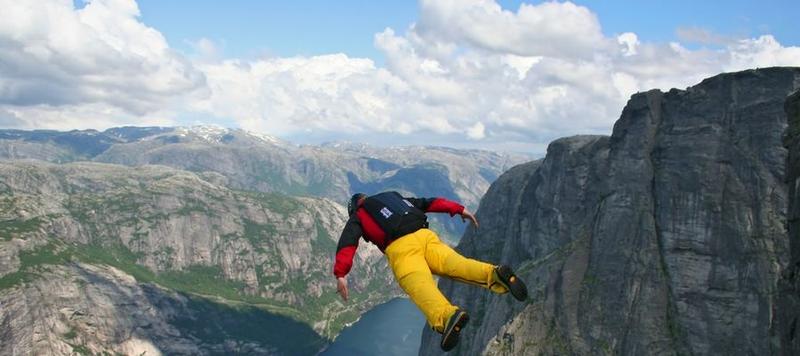So you’ve seen an awesome video of a guy jumping off a cliff in a wingsuit and now you want to do the same? Hang on. Wait a minute. Let’s back up.
BASE jumping is an extremely dangerous sport that’s not for novices. But the best way to get into it is to start skydiving! In fact, many equipment manufacturers and BASE training courses require you to have extensive skydiving experience first. Bear with us here. In this article, we’ll define what BASE jumping is and explain how you can get into it. Just remember, it takes a certain type of person to want to hurdle themselves toward Earth from a 500-foot bridge, cliff, or building. It’s not for everyone. In fact, it’s not for most people.
But if the urge keeps eating away at you despite the red flags, your best place to start is here with us at the skydiving dropzone.
What is BASE jumping?
BASE is an acronym that stands for Building – Antenna – Span – Earth. These are the four primary points from which BASE jumpers depart. Span is another word for bridge. Earth usually means a cliff.
The major two differences between skydiving and BASE jumping are that BASE jumpers have just one parachute (as opposed to two for skydivers — the main canopy and a backup reserve in case the first malfunctions), and BASE jumpers are significantly closer to the ground upon exit (a few hundred feet versus thousands for skydivers), meaning they have virtually zero margins for error.
A BASE jumper must exercise precision. First: their pack jobs. BASE jumpers pack their parachutes meticulously since they depend on just that one for their lives. Second: BASE jumpers must be perfect on exit. Since BASE jumpers exit into “dead air,” a slight wrong move can send them into an unstable spin. Third: BASE jumpers must be expert canopy pilots. Once their parachute deploys, BASE jumpers often have just a few seconds to figure out where they’re landing and they must do so with pinpoint accuracy.

How to Start Base Jumping
BASE jumping instructors tend to demand at least 200 skydives before bringing on a new student. However, many experienced jumpers would suggest you have hundreds more than that.
Ultimately, you must decide whether you’re ready to take on the increased risk that’s associated with BASE jumping. You must be comfortable enough with your exit and parachute piloting skills. Do not seek out a course until you’re an expert on both.
Skydiving helps you to work on those skills in a much more controlled environment. Practice exiting from the plane until you’re stable immediately upon exit. Practice precision piloting skills by picking a specific spot on the ground and aiming for it. Skydiving is a training tool for BASE jumping, much like how the wind tunnel is a training tool for skydivers.
Only once you’re an experienced skydiver and perfected those skills, seek out a BASE First Jump Course. Each has its own requirements, so make sure you meet all of those as well. Many of these courses tend to start jumpers off on bridges, such as Perrine Bridge in Twin Falls, Idaho, a 486-foot bridge that spans the Snake River.
Don’t forget to seek out mentors. It’s good to do this for skydiving as well, but it’s crucial to find an experienced mentor in the sport of BASE jumping because it’s a much smaller community. Understanding the successes and failures of the past could save your life.
Different Types of Base Jumping
Lastly, keep in mind that there are different types of BASE jumping. The most dangerous by far is called proximity wingsuit flying, when a jumper in a squirrel suit flies close to the ground, often zipping through valleys after departing from a cliff. These are likely the videos that initially enamored you and lured you into the sport. But it’s arguably the most dangerous sport in the world. Don’t get too excited and jump into something before you’re ready. Understand what could go wrong. Understand how skydiving can make you a better BASE jumper. Stay current. Oh yeah, and don’t forget to have fun. Book your skydive today!
Disclaimer: BASE jumping is an extremely dangerous sport that has killed many people. We don’t suggest you try it. But if you must, any action you take upon the information on this website is strictly at your own risk, and we will not be liable for any losses or damages in connection with the sport and its association with this site.
Copyright © 2025, Skydive Monroe, All Rights Reserved.
DropZone Web Design & Marketing by Beyond Marketing, LLC



